jump start MITSUBISHI SHOGUN 2003 Owner's Manual (in English)
[x] Cancel search | Manufacturer: MITSUBISHI, Model Year: 2003, Model line: SHOGUN, Model: MITSUBISHI SHOGUN 2003Pages: 392, PDF Size: 14.34 MB
Page 176 of 392
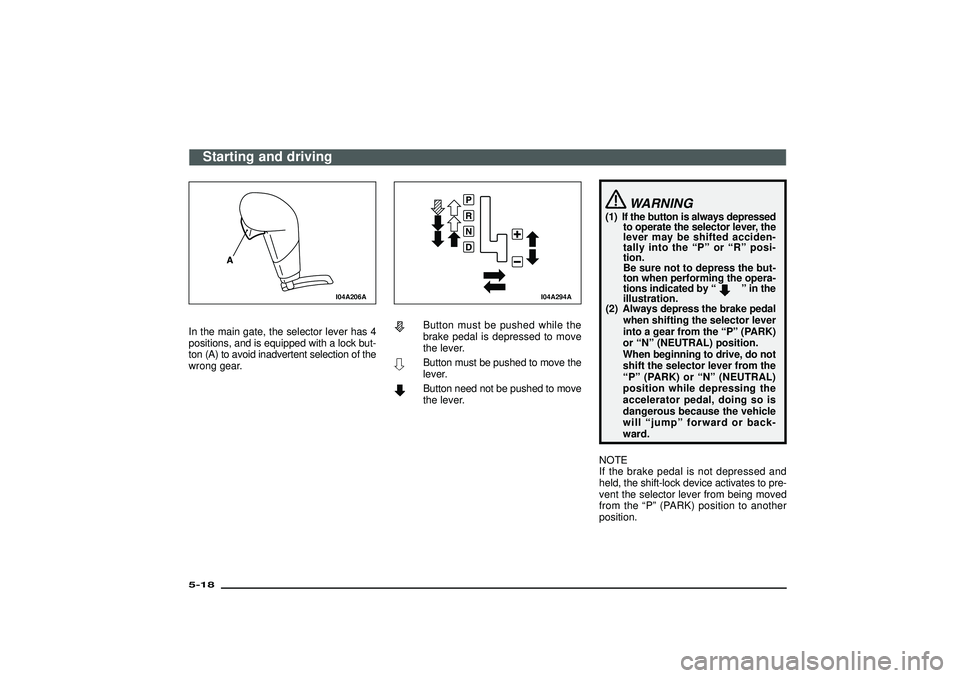
I04A206A
In the main gate, the selector lever has 4
positions, and is equipped with a lock but-
ton (A) to avoid inadvertent selection of the
wrong gear.
I04A294A
Button must be pushed while the
brake pedal is depressed to move
the lever.Button must be pushed to move the
lever.Button need not be pushed to move
the lever.
WARNING
(1) If the button is always depressed
to operate the selector lever, the
lever may be shifted acciden-
tally into the“P”or“R”posi-
tion.
Be sure not to depress the but-
ton when performing the opera-
tions indicated by“
”in the
illustration.
(2) Always depress the brake pedal
when shifting the selector lever
into a gear from the“P”(PARK)
or“N”(NEUTRAL) position.
When beginning to drive, do not
shift the selector lever from the
“P”(PARK) or“N”(NEUTRAL)
position while depressing the
accelerator pedal, doing so is
dangerous because the vehicle
will“jump”forward or back-
ward.
NOTE
If the brake pedal is not depressed and
held, the shift-lock device activates to pre-
vent the selector lever from being moved
from the“P”(PARK) position to another
position.
Starting and driving
5-18Div:
Out put date:
Page 205 of 392
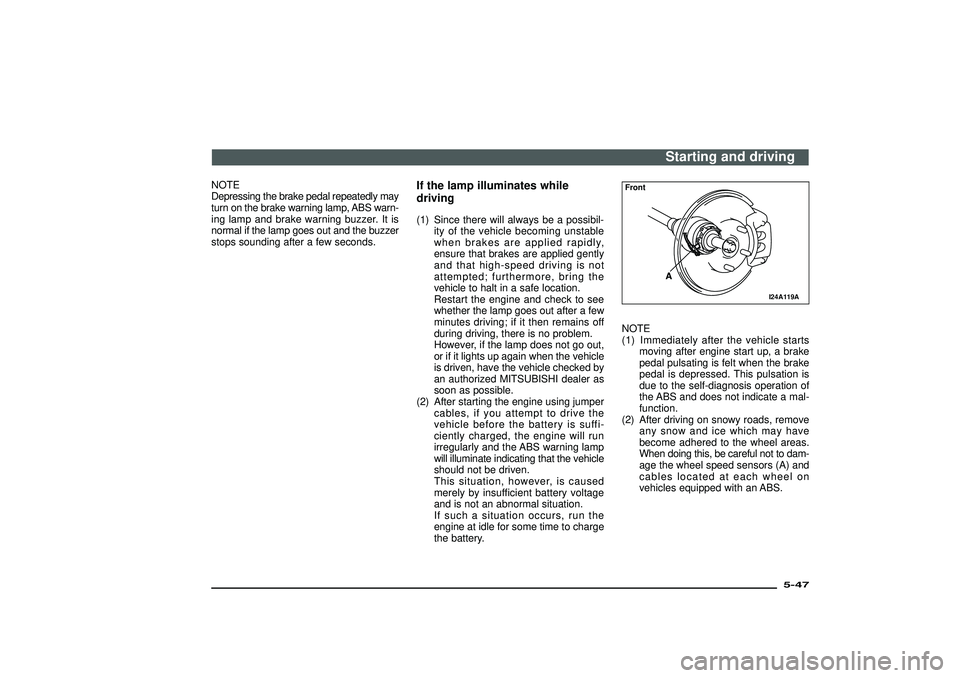
NOTE
Depressing the brake pedal repeatedly may
turn on the brake warning lamp, ABS warn-
ing lamp and brake warning buzzer. It is
normal if the lamp goes out and the buzzer
stops sounding after a few seconds.
If the lamp illuminates while
driving(1) Since there will always be a possibil-
ity of the vehicle becoming unstable
when brakes are applied rapidly,
ensure that brakes are applied gently
and that high-speed driving is not
attempted; furthermore, bring the
vehicle to halt in a safe location.
Restart the engine and check to see
whether the lamp goes out after a few
minutes driving; if it then remains off
during driving, there is no problem.
However, if the lamp does not go out,
or if it lights up again when the vehicle
is driven, have the vehicle checked by
an authorized MITSUBISHI dealer as
soon as possible.
(2) After starting the engine using jumper
cables, if you attempt to drive the
vehicle before the battery is suffi-
ciently charged, the engine will run
irregularly and the ABS warning lamp
will illuminate indicating that the vehicle
should not be driven.
This situation, however, is caused
merely by insufficient battery voltage
and is not an abnormal situation.
If such a situation occurs, run the
engine at idle for some time to charge
the battery.
I24A119A
FrontNOTE
(1) Immediately after the vehicle starts
moving after engine start up, a brake
pedal pulsating is felt when the brake
pedal is depressed. This pulsation is
due to the self-diagnosis operation of
the ABS and does not indicate a mal-
function.
(2) After driving on snowy roads, remove
any snow and ice which may have
become adhered to the wheel areas.
When doing this, be careful not to dam-
age the wheel speed sensors (A) and
cables located at each wheel on
vehicles equipped with an ABS.
Starting and driving
5-47
Div:
Out put date:
Page 206 of 392
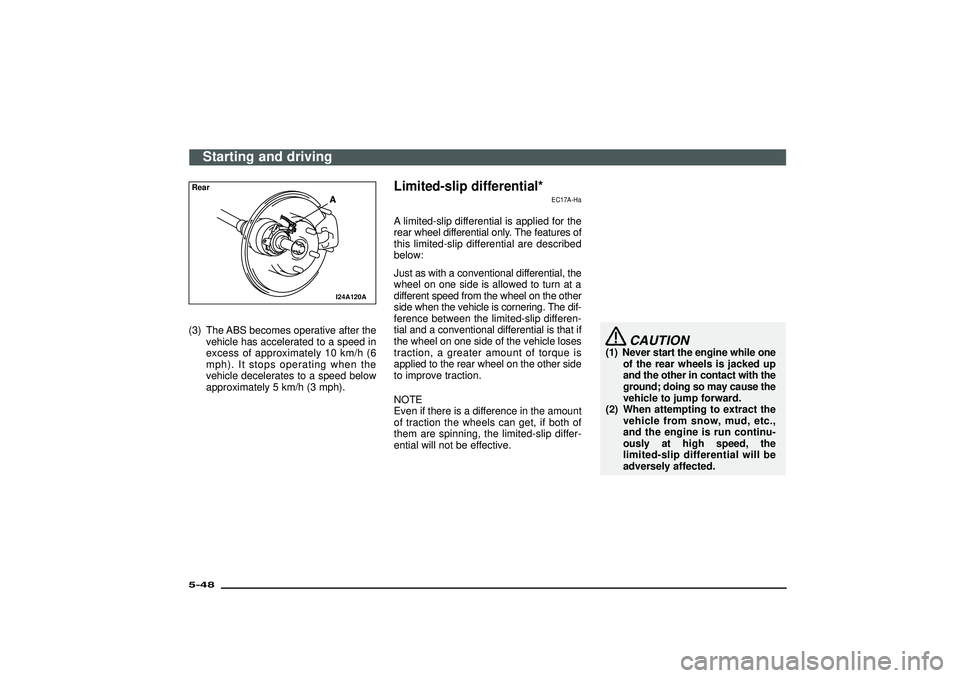
I24A120A
Rear(3) The ABS becomes operative after the
vehicle has accelerated to a speed in
excess of approximately 10 km/h (6
mph). It stops operating when the
vehicle decelerates to a speed below
approximately 5 km/h (3 mph).
Limited-slip differential*
EC17A-Ha
A limited-slip differential is applied for the
rear wheel differential only. The features of
this limited-slip differential are described
below:
Just as with a conventional differential, the
wheel on one side is allowed to turn at a
different speed from the wheel on the other
side when the vehicle is cornering. The dif-
ference between the limited-slip differen-
tial and a conventional differential is that if
the wheel on one side of the vehicle loses
traction, a greater amount of torque is
applied to the rear wheel on the other side
to improve traction.
NOTE
Even if there is a difference in the amount
of traction the wheels can get, if both of
them are spinning, the limited-slip differ-
ential will not be effective.
CAUTION
(1) Never start the engine while one
of the rear wheels is jacked up
and the other in contact with the
ground; doing so may cause the
vehicle to jump forward.
(2) When attempting to extract the
vehicle from snow, mud, etc.,
and the engine is run continu-
ously at high speed, the
limited-slip differential will be
adversely affected.
Starting and driving
5-48Div:
Out put date:
Page 323 of 392
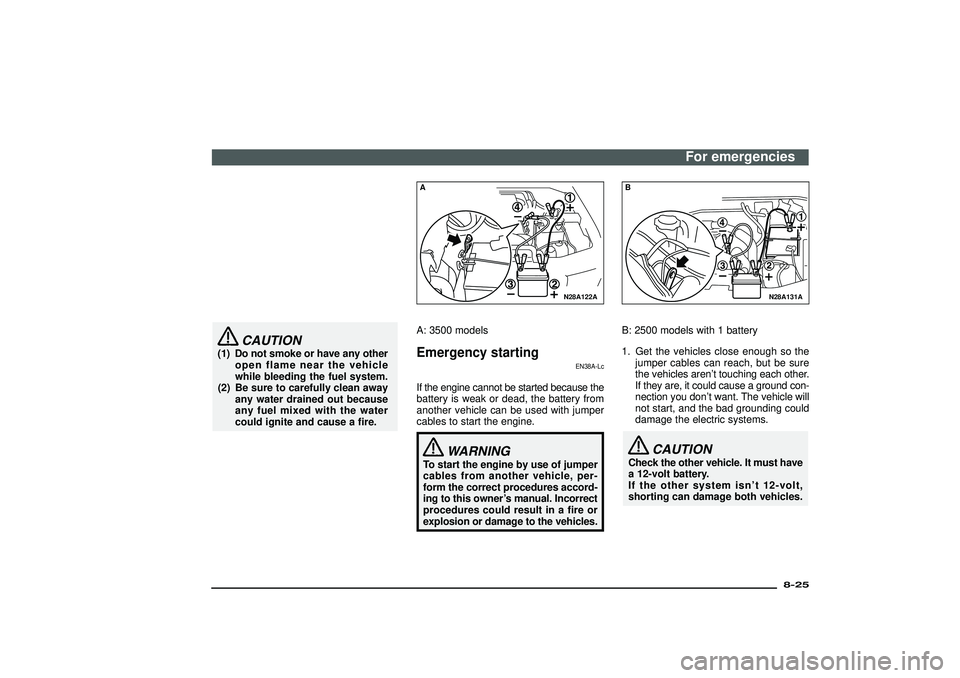
CAUTION
(1) Do not smoke or have any other
open flame near the vehicle
while bleeding the fuel system.
(2) Be sure to carefully clean away
any water drained out because
any fuel mixed with the water
could ignite and cause a fire.
N28A122A
AA: 3500 modelsEmergency starting
EN38A-Lc
If the engine cannot be started because the
battery is weak or dead, the battery from
another vehicle can be used with jumper
cables to start the engine.
WARNING
To start the engine by use of jumper
cables from another vehicle, per-
form the correct procedures accord-
ing to this owner’s manual. Incorrect
procedures could result in a fire or
explosion or damage to the vehicles.
N28A131A
BB: 2500 models with 1 battery
1. Get the vehicles close enough so the
jumper cables can reach, but be sure
the vehicles aren’t touching each other.
If they are, it could cause a ground con-
nection you don’t want. The vehicle will
not start, and the bad grounding could
damage the electric systems.
CAUTION
Check the other vehicle. It must have
a 12-volt battery.
If the other system isn’t 12-volt,
shorting can damage both vehicles.
For emergencies
8-25
Div:
Out put date:
Page 324 of 392
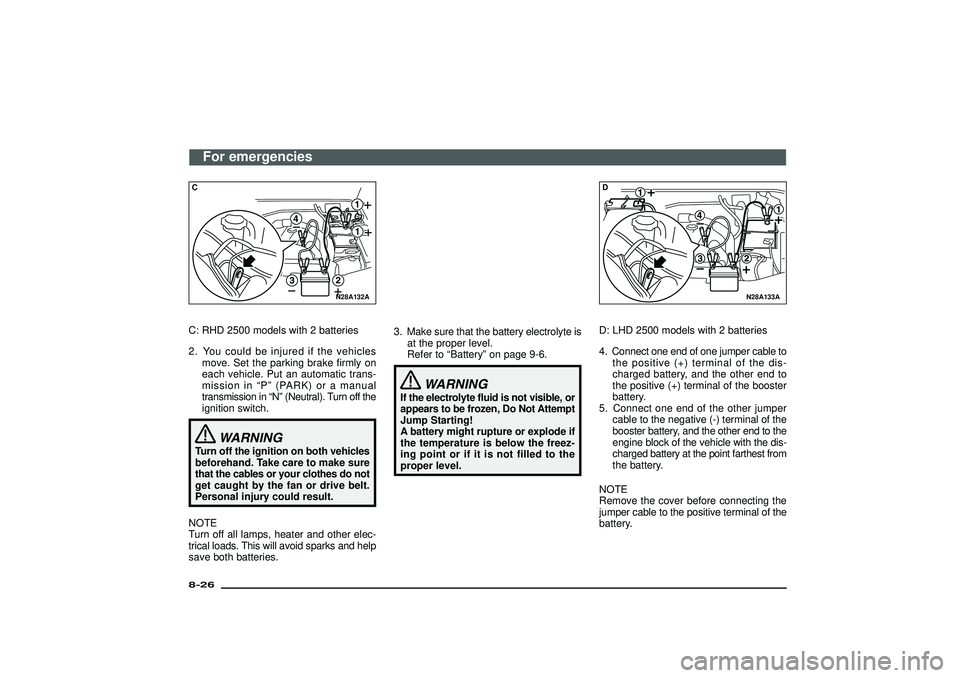
N28A132A
CC: RHD 2500 models with 2 batteries
2. You could be injured if the vehicles
move. Set the parking brake firmly on
each vehicle. Put an automatic trans-
mission in“P”(PARK) or a manual
transmission in“N”(Neutral). Turn off the
ignition switch.
WARNING
Turn off the ignition on both vehicles
beforehand. Take care to make sure
that the cables or your clothes do not
get caught by the fan or drive belt.
Personal injury could result.
NOTE
Turn off all lamps, heater and other elec-
trical loads. This will avoid sparks and help
save both batteries.3. Make sure that the battery electrolyte is
at the proper level.
Refer to“Battery”on page 9-6.
WARNING
If the electrolyte fluid is not visible, or
appears to be frozen, Do Not Attempt
Jump Starting!
A battery might rupture or explode if
the temperature is below the freez-
ing point or if it is not filled to the
proper level.
N28A133A
DD: LHD 2500 models with 2 batteries
4. Connect one end of one jumper cable to
the positive (+) terminal of the dis-
charged battery, and the other end to
the positive (+) terminal of the booster
battery.
5. Connect one end of the other jumper
cable to the negative (-) terminal of the
booster battery, and the other end to the
engine block of the vehicle with the dis-
charged battery at the point farthest from
the battery.
NOTE
Remove the cover before connecting the
jumper cable to the positive terminal of the
battery.
For emergencies
8-26Div:
Out put date:
Page 325 of 392
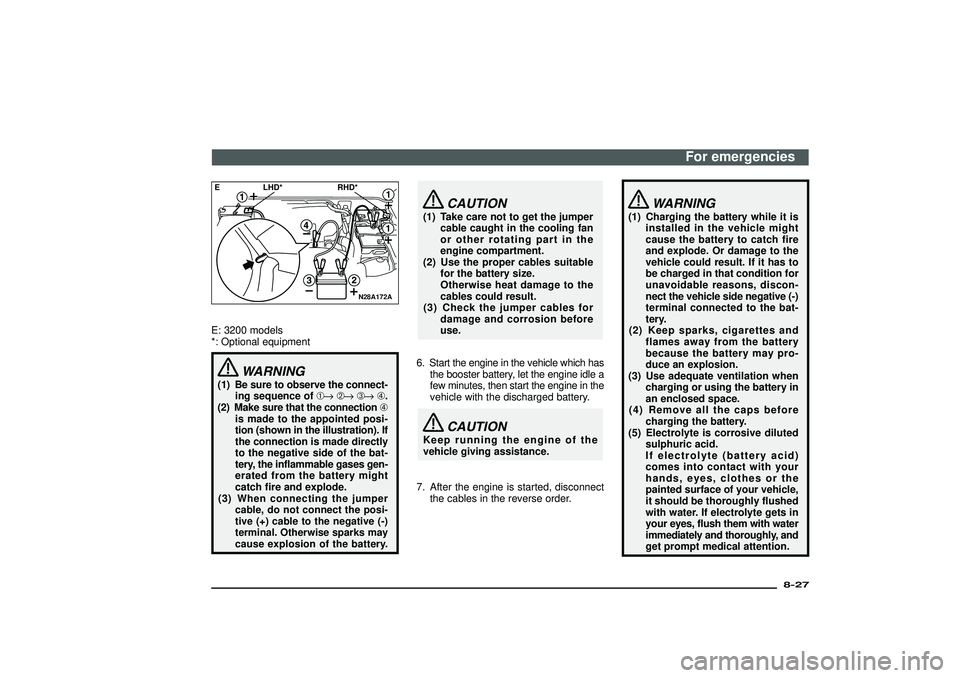
N28A172A
E LHD* RHD*E: 3200 models
*: Optional equipment
WARNING
(1) Be sure to observe the connect-
ing sequence of➀→➁→➂→➃.
(2) Make sure that the connection➃
is made to the appointed posi-
tion (shown in the illustration). If
the connection is made directly
to the negative side of the bat-
tery, the inflammable gases gen-
erated from the battery might
catch fire and explode.
(3)
When connecting the jumper
cable, do not connect the posi-
tive (+) cable to the negative (-)
terminal. Otherwise sparks may
cause explosion of the battery.
CAUTION
(1) Take care not to get the jumper
cable caught in the cooling fan
or other rotating part in the
engine compartment.
(2) Use the proper cables suitable
for the battery size.
Otherwise heat damage to the
cables could result.
(3) Check the jumper cables for
damage and corrosion before
use.
6. Start the engine in the vehicle which has
the booster battery, let the engine idle a
few minutes, then start the engine in the
vehicle with the discharged battery.
CAUTION
Keep running the engine of the
vehicle giving assistance.
7. After the engine is started, disconnect
the cables in the reverse order.
WARNING
(1) Charging the battery while it is
installed in the vehicle might
cause the battery to catch fire
and explode. Or damage to the
vehicle could result. If it has to
be charged in that condition for
unavoidable reasons, discon-
nect the vehicle side negative (-)
terminal connected to the bat-
tery.
(2) Keep sparks, cigarettes and
flames away from the battery
because the battery may pro-
duce an explosion.
(3) Use adequate ventilation when
charging or using the battery in
an enclosed space.
(4) Remove all the caps before
charging the battery.
(5) Electrolyte is corrosive diluted
sulphuric acid.
If electrolyte (battery acid)
comes into contact with your
hands, eyes, clothes or the
painted surface of your vehicle,
it should be thoroughly flushed
with water. If electrolyte gets in
your eyes, flush them with water
immediately and thoroughly, and
get prompt medical attention.
For emergencies
8-27
Div:
Out put date: